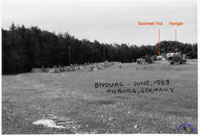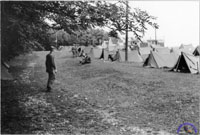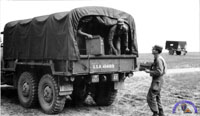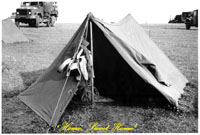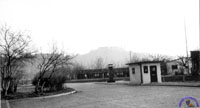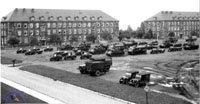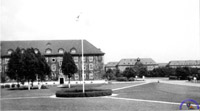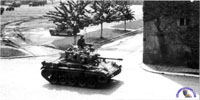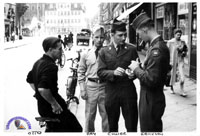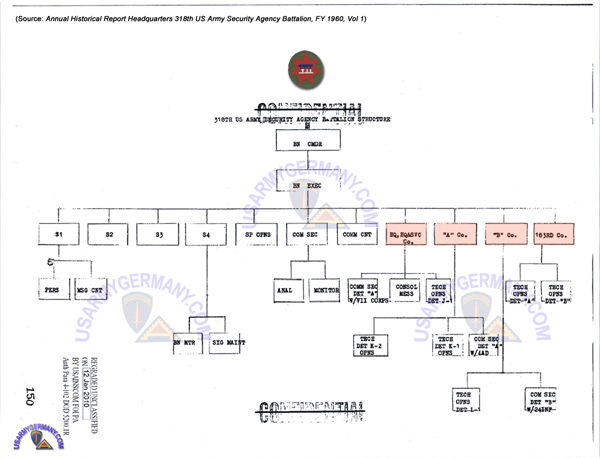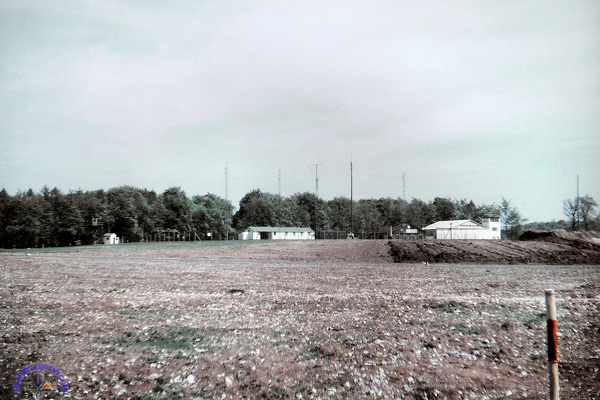| If you do NOT see the Table of Contents frame to the left of this page, then Click here to open 'USArmyGermany' frameset |
||||||||||||||||||||
|
318th ASA Battalion (Corps) |
||||||||||||||||||||
|
|
||||||||||||||||||||
|
||||||||||||||||||||
|
|
||||||||||||||||||||
| 302nd Army Security Agency Battalion | ||||||||||||||||||||
| 302nd Communications Reconnaissance Battalion | ||||||||||||||||||||
| 1945 - 1956 | ||||||||||||||||||||
| (Source: Historical Summary of the 302nd MI Battalion (Opns), HQ 302nd MI Bn, APO 09710) | ||||||||||||||||||||
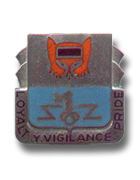 302nd US Army Security Agency Bn DUI 302nd US Army Security Agency Bn DUI |
||||||||||||||||||||
| The lineage of the 302nd MI Battalion (Opns) can be traced to the 3252nd Signal Service Company which was constituted and activated in England on 1 April 1944. The unit was assigned to the European Theater of Operations. After serving in England, France, and Germany the Battalion was returned to the United States where it was inactivated, effective 24 November 1945. The 3252nd Signal Service Company was redesignated as the 533rd Signal Service Company on 6 May 1948 and activated at Salzburg, Austria, on 20 July 1948, with assignment to the European Command. It supported the US Forces in Austria. It was inactivated at Salzburg, effective 1 April 1949. The 533rd SSC was redesignated as Headquarters and Headquarters Detachment, 302nd Communications Reconnaissance Battalion, effective 13 October 1950 and was activated at Camp Pickett, Virginia, on 20 October 1950. The 302nd was a "paper" organization until 11 May 1951 when it relieved the 501st Communications Reconnaissance Group of all ASA training units. The unit transferred to Fort Devens, Mass. closing there on 2 July 1951. Assigned strength of the Battalion at that time was 5 officers and 21 enlisted men. On 1 November 1951, the requisition of personnel and equipment to 100 percent of strength was authorized. The 302nd participated in Exercise LONGHORN at Fort Hood, Texas, during February, March and April, 1952. The Battalion transferred to Germany in July 1952, departing Fort Devens on 16 July and arriving at Camp Kilmer, New Jersey for staging the same day. It departed the New York Port of Embarkation on 25 July on the USNS General Taylor and arrived in Bremerhaven, Germany, on 3 August 1952. The Battalion was located at the Badenerhof Kaserne in Heilbronn and was assigned to the 502nd Communications Reconnaissance Group. During the last week of August, the 332nd and 354th Communications Reconnaissance Companies were assigned to the 302nd. The 302nd served primarily as an administrative headquarters, overseeing the 354th CR Company, which provided security monitoring support to elements of VII Corps and attached units (5rh and 9th Infantry Divisions), and the 332nd CR Company, which provided communications intelligence support. The Battalion and its companies participated in various field exercises throughout the period. On 15 March 1955, the Battalion relocated from Heilbronn to Warner Kaserne, Bamberg where it underwent a major reorganization. On 22 June, Company A, 302nd CR Battalion was organized and assumed the communications security mission of the 354th CR Company, which was returned to the Organized Reserves. For the first time, the (Headquarters abd Headquarters Company of the) Battalion began to perform an active operational mission, assuming a portion of the 332nd Company's assignments. Within a year, the Battalion had outstations located at Giebelstadt, Stuttgart, Hof, Altefeld, Coburg, Fürth, and Berlin. Also on 22 June 1955, Headquarters and Headquarters Detachment, 302nd CR Bn was redesignated as Headquarters Company, 302nd CR Battalion. 1956 - 1957 302nd US Army Security Agency Battalion On 1 July 1956, the Battalion was redesignated as the 302nd Army Security Agency Battalion. In September 1956, the 302nd relocated from Bamberg to Herzogenaurach, Germany. It was inactivated there on 15 October 1957 and concurrently the 318th US Army Security Agency Battalion was organized as a replacement TD unit. |
||||||||||||||||||||
| 1975 - 1984 302nd Army Security Agency Battalion (Corps) Effective 21 December 1975, Headquarters and Headquarters Company, 302nd ASA attalion (Corps) was reactivated at Frankfurt, Germany, and assigned to the 502nd ASA Group in support of V Corps. On 1 January 1977, the Battalion was transferred from HQ US Army Security Agency to US Army, Europe and further assigned to V Corps. Effective 16 April 1984, the 302nd ASA Bn was reorganized as the 302nd Military Intelligence Battalion (Opns)(Corps) and subordinated to the 205th MI Group of V Corps under the Combat Electronics Warfare Intelligence (CEWI) Concept. The subsequent historical activities of this V Corps unit will be covered on the 205th MI Group Page. |
||||||||||||||||||||
| 332nd Communications Reconnaissance / ASA Company | ||||||||||||||||||||
| (Source: Email from Chuck Bowen, 328th CR Co and 332nd CR Co, 1952-1954) | ||||||||||||||||||||
I went over to Germany with the advanced party of the 328th CRC when we opened Bad Aibling FS. in 1952. The 328th was formed at Fort Devens and trained there prior to shipping out on the MSTS Balleau for Bremerhafen, and from there by train to Bad Aibling. Shortly after arrival of the company I was "traded" to the 332nd CRC for experienced personnel. Probably 25 percent of the original 328th ended up in other units for this reason. The 332 CRC was located at Hof, Germany when I reported in. As I was an HSRO I was assigned to the DF site and worked DF the rest of my time in the 332nd. The Company returned to Heilbronn for the winter. My DF site was then relocated to Bindlach, which is close to Bayreuth. We spent a long winter there and in the spring moved to the Flugplatz above the Veste in Coburg. DF sites were pretty much "stand alone" units at this time with not much physical contact with the company. I had to fill in on sites at Rotz (Waldmuenchen), Roth (Ansbach), Furth im Wald and Memmingen when personnel went on leave or ETS'd. The 332 moved to Bamberg in 1954 and I ETS'd in May of that year. As I think you know the 332nd was formed from the old 116 Signal Service Company which was located in Scheyern, Germany. Scheyern became a Field Station at that time. I returned home and finished school at CCNY. After graduating I went back to work for the Government. |
||||||||||||||||||||
| (Source: Webmaster's collection) During the fiscal year 1953, the 332nd Communications Reconnaissance Company, with home station at Baumholder, operated out of Harris Barracks, Coburg during a 5-month TDY. The operations site during this period was set up at the Coburg Arstrip which was located close to the Coburg Veste. As Jim Clinton, 116th SSC, relates in his personal recollections, "In the spring of 1952 the unit again march ordered up to Coburg where operations were set up on the flugplatz and pup tents were again pitched in the woods. After a few weeks the troops were billeted in the kaserne now occupied by the newly formed Bundesgrenshutz (German border patrol that had replaced the Constabulary). Normal garrison living resumed with Saturday inspections in ranks outside and in quarters inside being the highlight of the week." |
||||||||||||||||||||
| 318th Army Security Agency Battalion | ||||||||||||||||||||
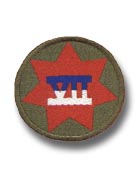 Patch worn by the 318th USASA Bn (Corps) Patch worn by the 318th USASA Bn (Corps) |
||||||||||||||||||||
| ANNUAL HISTORICAL REPORT - FISCAL YEAR 1958 (VOLUME 1) | ||||||||||||||||||||
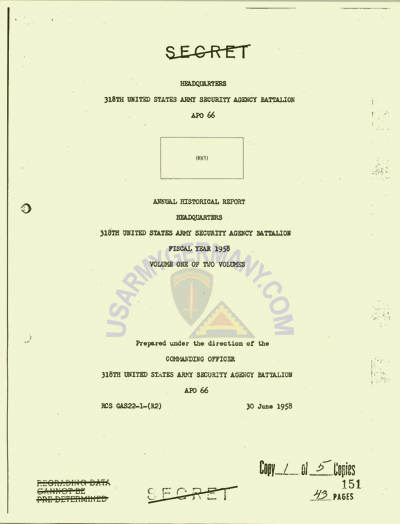 |
||||||||||||||||||||
 |
||||||||||||||||||||
| I have posted a scan of the 318th USASA Battalion Unit History (FY1958) that was recently declassified under FOIA. This is Volume 1 of 2. Vol. 2 was almost completed redacted and will not be presented here. The Appendixes for Vol. 1 was also withheld and is not posted. Other years and other ASA units to follow.... |
||||||||||||||||||||
| 1957 - 1971 | ||||||||||||||||||||
 318th US ASA Bn DUI 318th US ASA Bn DUI |
||||||||||||||||||||
| On 15 Oct 1957, the 302nd ASA Bn was inactivated in Herzogenaurach. The Bn's personnel and mission were transferred to the concurrently organized 318th USASA Bn, a tables of distribution and allowances (TDA) unit. At the same, the 183rd USASA Company was formed. It held the Operators and T/A's from other units around Germany, including from the 339th ASA Co. Initially, the main operations (intercept) work at Herzo was done by the 6th USASA Field Station. But, it appears that in March 1959, 6th USASA Fld Sta merged into the 183rd ASA Co, 318th ASA Bn. Personnel and mission of Detachment L, 180th USASA Co at Nottau near the Czech/Austrian, were transferred to the 318th USASA Bn in April or May of 1958. The unit became Detachment K-2, Co A, 318th USASA Bn. On 15 May 1960, the 182nd USASA Co was relieved from assignment to the 319th USASA Bn and reassigned to the 318th. Det A, A Co (1), 318th in Göppingen provided COMSEC support to 4th Armd Div. Det B, A Co, 318th in Würzburg provided COMSEC support to 3rd Inf Div. In addition to manning Herzo Base, the 318th also maintained several outstations at Schneeberg (Det J-1), Mähring (Det L-1) and Hoherbogen (Det K). (Source: Paul Mowrey) Det K-1 at Coburg needs to be added. The detachment was in Coburg from the 1951 to the early 1960s. It was still there in 1962. In the early 1960's, a detachment of the 279th ASA Company, with HQs in Frankfurt, was located at Schneeberg. That detachment was transferred to the 318th USASA Bn and redesignated as Det J-1 of HQ/HQ and Svc Company, 318th ASA Bn. The detachment operated a fixed field site using the AN/ALR-8 and the AN/TLR-1. In the latter years, the Battalion was designed to keep all of the tactical equipment and during hostilities, get personnel from the Field Station at Herzo as fillers. The battalion would exercise this aspect several times a year. The 318th ASA Bn was discontinued on 3 May 1971 as a result of an effort to centralize ASA operations in Germany at a new station at Augsburg, Germany. When Field Station Herzogenaurach was discontinued on 30 June 1972, it also marked the end of ASA's presence at Herzo Base. Herzo Base was turned over to a US artillery unit and subsequently became known as Herzo Arty Base. CORRECTION: (1) I enjoyed your web page "Army Security Agency, Europe", however I found an error concerning the 318th USASA Bn. Det. A located in Goeppingen (in support of the 4th Armored Div.) it was a part of "A" Co. not "B" Co. I was an 055 (05G) stationed there from 9/1963 to 6/1965. I greatly appreciate the work you folks do on these ASA web pages. I have made contact with some of the people I served with and hadn't seen for 40 years through these pages. Charlie Long. (2) In your history of the 318th ASA Bn you listed the following: Det B, A Co, 318th in Würzburg provided COMSEC support to 3rd Inf Div. This is incorrect. It was Co. B that supported the 3rd Inf Div. I know because I was part of it and went to the field several times supporting the division. Co. A did support the 4th Armd. Div. Co. A was track (APC) mounted and Co B was truck mounted. They were called maneuver support companies giving the COMSEC support. I was with the 182nd ASA Co. from Jul 1963 to Oct 1964 and with Co. B from Oct 1964 to Aug 1965. I was a 982. I got an early out (71 days) to go back to college. Robert B. (Bob) van Hoosee |
||||||||||||||||||||
| (Source: Email from Charles "Chuck" E. Davis, Det K-1, Coburg, Feb 1957 - Feb 1959) | ||||||||||||||||||||
| I just found your site and was reminiscing a little. I remember some things from the past very well and other things very faint or '''sketchy' or not at all. I can't find references to our Detachment on your site. May have overlooked it. I do see that under the link Kasernes, Harris Barracks which is located within the Hindenburg Kaserne and consisted of one 3-story old SS barrack and other buildings which were used by the AC unit and our ASA Det. The kaserne was a Bundesgrenschutz base which we shared a small part of. We (I think, no longer sure) were Det K-1, Company B,(maybe A) 302nd ASA Bn at Coburg, then later, the 318th USASA Bn. Hq was in Herzogenaurach. We had the top floor of an SS Barracks at the Hindenburg Kaserne outside Coburg. The Armored Cavalry had the bottom 2 floors. Primarily the 2nd A/C but sometimes other units. Our Operations site was on a hill adjacent to the Veste Coburg. It had been a Luftwaffe airstrip (very small) and was owned by the US Army at the time I was there. It now is owned by city of Coburg, I think. Civilians used the airport for a few private small planes and gliders. The Hummel figurine President had a plane there, very nice man. Hummel is a brand owned by the same family for generations. Can't think of the name right now. The factory is in a little town near Coburg. We had an operations building surrounded by concertina wire (later a cyclone fence). The first ops bldg was an old metal Quonset hut which burned while I was there. The Corps of engineers replaced it with a larger, more modern wooden pre-fab structure. I was a trick chief while there, for most of my 2 yrs there. I don't remember the trick designation anymore. I was there from Feb 1957 through Feb 1959. We used to go to Warner Barracks in Bamberg for "sick call" or hair cuts and shopping at PX. We had a very small PX in Coburg but you couldn't get much there. I usually got my hair cut in Coburg at a local German barber shop. I also went to Berlin TDY for 30 days, which was extended to 47 days because the E.Germans and Russians closed every thing off and we were unable to leave. I worked on a special project called Mecury Grass at Templehof. I believe that was around October- November '58. Could have been '57. ) |
||||||||||||||||||||
| (Source: Email from Paul Mowrey, Det K-1, Coburg, 1957-58) | ||||||||||||||||||||
| DET K-1 (Coburg) An excellent historical source. I have a small addition pertaining to the 302/318th USASA Battalion. In the sentence that says: "In addition to manning Herzo Base, the 318th also maintained several outstations at Schneeberg (Det.J.), Mähring (Det. L-1), and Hohenbogen (Det K)," I would also add Coburg (Det K-1) for complete accuracy. The detachment was in Coburg from the 1951 to the early 1960s; it was still there in 1962. Maybe someone else knows its closing date. The development of Schneeberg and Hohenbogen may have made Coburg unneccessary. I was stationed there in 1957-58. The primary mission at Coburg when I was there was intercepting Russian and German voice traffic, mostly tank units in some phase of their training cycle. I was part of about 10 students who graduated from the ASA Voice Intercept School in Feb, 1957. After the surge in traffic from the Hungarian Revolution and perhaps to attain more central control over what is going on, the Army decided to upgrade Russian language transcription services. This effort was headed by CWO Owen Yates it the 502nd (GP) in Heilbronn. All transcription material from Lübeck, Bahrdorf, Coburg, and Passau came to Heilbronn to be checked or cross referenced. After we gained some experience we were sent out to the 302nd and 307th. I went in July and was joined by classmate John Hamer in August. So I spent the rest of my time in Coburg. During this period other higher types of traffic was discovered but I never had anything to do with it. We were probably the next to the last class to go through the ASA Voice Interecept School at Devens. After mid 1957 no one had touched a receiver. |
||||||||||||||||||||
| 1960 | ||||||||||||||||||||
| (Source: Annual Historical Report of 318th US Army Security Agency Battalion, FY 1960, Vol 1) | ||||||||||||||||||||
| 1962 | ||||||||||||||||||||
| (Source: Email from Tom Brennan) | ||||||||||||||||||||
| I never see much if any mention of Det K-2 at Nottau, Germany. I was stationed there around 1963 - 1964.
I have seen some FB posts of guys that were there in late 50's but not my era. There was only about 12 of us: 2 Crippies, maybe 6 or 7 Marys (Russian), 1 maintenance, a detachment commander (1st or 2nd LT) and an NCOIC. A couple names I remember are Kirby Hudson, Harry Watson, an NCO I believe his last name was Christen (spelling). Of course there was also BeeBar, the dog. I had a room in a barn down the road from the compound. Also, Det K-2 Nottau was under the 318th, forget what company though. I believe it closed down sometime in 64 maybe. Can anyone confirm this? I sure would like to hear from some other people that were there then. |
||||||||||||||||||||
| 1964 | ||||||||||||||||||||
| (Source: Email from David J. Foggatt) | ||||||||||||||||||||
In his email, Paul Mowrey (Det K-1, Coburg 1957-58) says that he doesn't know when the Coburg outstation was closed down. Since I was, to the best of my knowledge, the last person to leave, I thought I might provide the missing information. |
||||||||||||||||||||
| 182nd ASA Company | ||||||||||||||||||||
| (Source: Email from Vandy Williams) | ||||||||||||||||||||
| This chronology is as I heard it at the 334th CR Co / 339th ASA Co reunion in Somerset, PA. The 334th Communications Reconnaisance Company was formed on paper at Fort Ft.Devens in late 1952 and was a school unit in early 1953. It went to Mannheim, Germany (Funari Kaserne) in late 1953 after schooling at Devens. In early 1954, the unit went to Eschwege -- this was a field operation, no billets (Tents), strictly field. In the Fall of 1954 it was transferred to Herzogenaurach as a Mobile Unit but with regular base billets (Herzo Base). In Nov 1954, the 334 was changed to the 339th CR Co. Within 2 or 3 Months it became the 339th ASA Company, still located at Herzo Base. In May 1956 the 339th ASA was transferred to Rothwesten near Kassel. It remained there as the 339 ASA until Jan 1958, when it became the 182nd ASA Operations Co. I was told the 182nd ASA was then attached to the 319th ASA Bn, still at Rothwesten. In the mid 1960's, the 182nd was detached and went back to Herzo Base were it remained until they closed Herzo as an ASA post and a Field Arty Unit came on base. I don't think there is any other lineage after that. The personnel were probably rolled into some of the many fixed stations around Germany. Hope this helps your data bank. |
||||||||||||||||||||
| 183rd ASA Company | ||||||||||||||||||||
| (Sources: Email from Matt Walkawicz, 183rd ASA Co, Herzogenaurach) | ||||||||||||||||||||
| Don't know how much you know about Herzo but it was home to the 318th USASA Bn (Corps), subordinate to 7th Corps. The 318th was the only unit stationed at Herzo while I was there. The 318th was made up of two operations companies, the 182nd and 183rd. Other units of the 318th were A, B, and C companies (small companies that primarily supported outstations, detachments and the like) plus Hq and Hq Co. I was there two different times. First tour was Feb 1961 until May 1963 serving as an 058 "ditty bopper" on Baker Trick, 183rd. My second tour was Sept 1965 until Aug 1966 serving as a 988, (later) 98G Czech linguist, assigned to B Company and detachment, Mount Hohenbogen, Rimbach. If my memory serves me, while there in 1965-66, the 182nd and 183rd became the 16th USASA Field Station, but A, B, and C companies remained as core of the 318th Bn. Have fond memories of my time at Herzo. I believe I was indeed a fortunate young troop to be assigned to Herzo Base and Germany. I do recall the tension caused by the development of the Berlin Wall in the summer of 1961 and, of course, the Cuban Missile crisis in October 1962. But all in all, it was a special time of my life. I guess I'm starting to ramble so I''ll stop here and get this out to you. |
||||||||||||||||||||
| (Sources: various) | ||||||||||||||||||||
| In 1960 there were two remote detachments operated by the 183rd ASA Opns Co and located at Giebelstadt Air Base and Straubing. They performed the RDF mission. The Straubing detachment was later moved to Memmingen. (It appears that the Giebelstadt Det might have been moved to Sinzig in late 1963, but only for a short period. It then returned to Giebelstadt.) 183rd ASA Co was one of three ASA operations companies moved to Augsburg to help set up the consolidated Field Station there in 1968. |
||||||||||||||||||||
| Related
Links Wurmberg - nice page on the ASA site at Wurmberg. Page is hosted on the German website - LostPlaces.de Gatow and Wobeck - nice page on the ASA sites at Gatow and Wobeck. Great photos of the Torii Towers!! Page is hosted on the German website - LostPlaces.de ASA Veterans Reunions - a guestbook that specializes in organized ASA reunions. |
||||||||||||||||||||
|
||||||||||||||||||||


